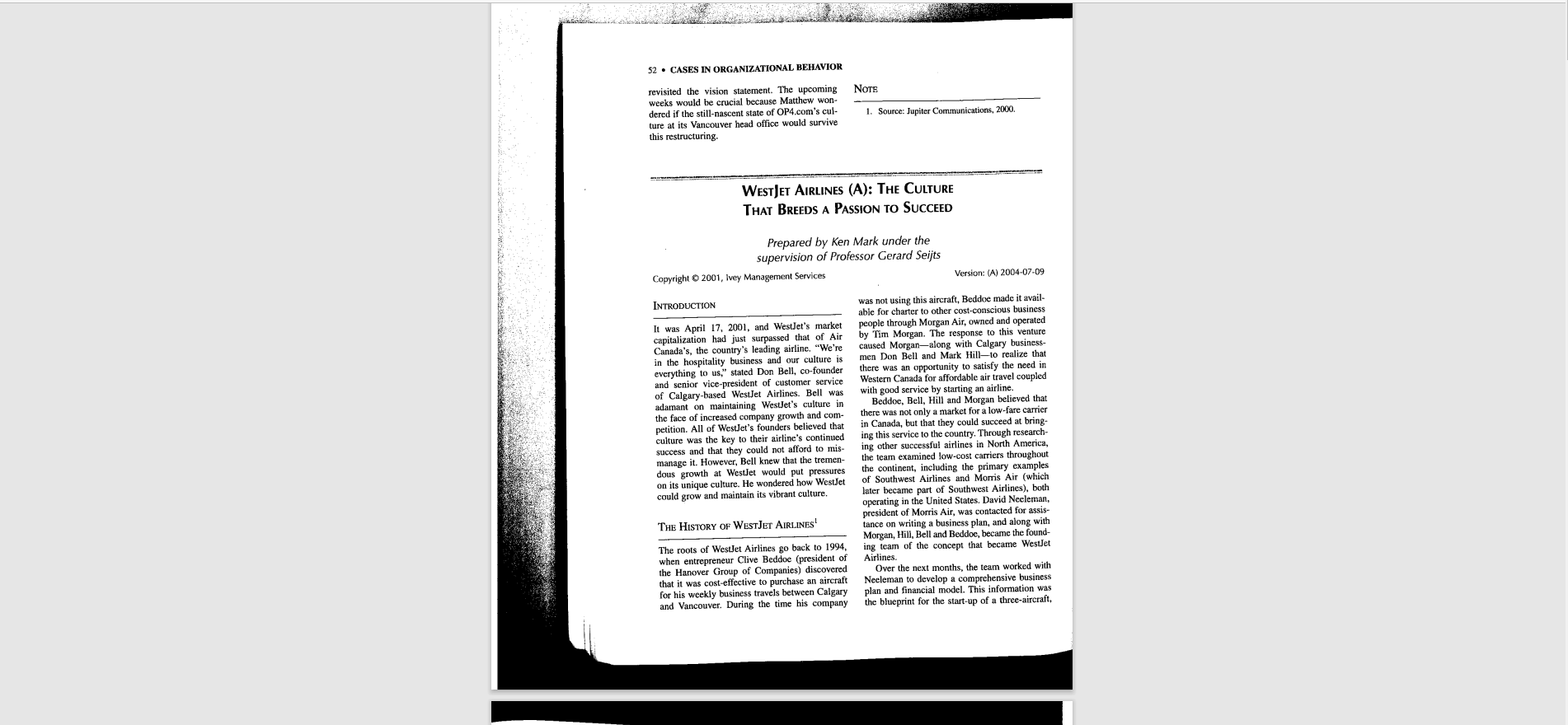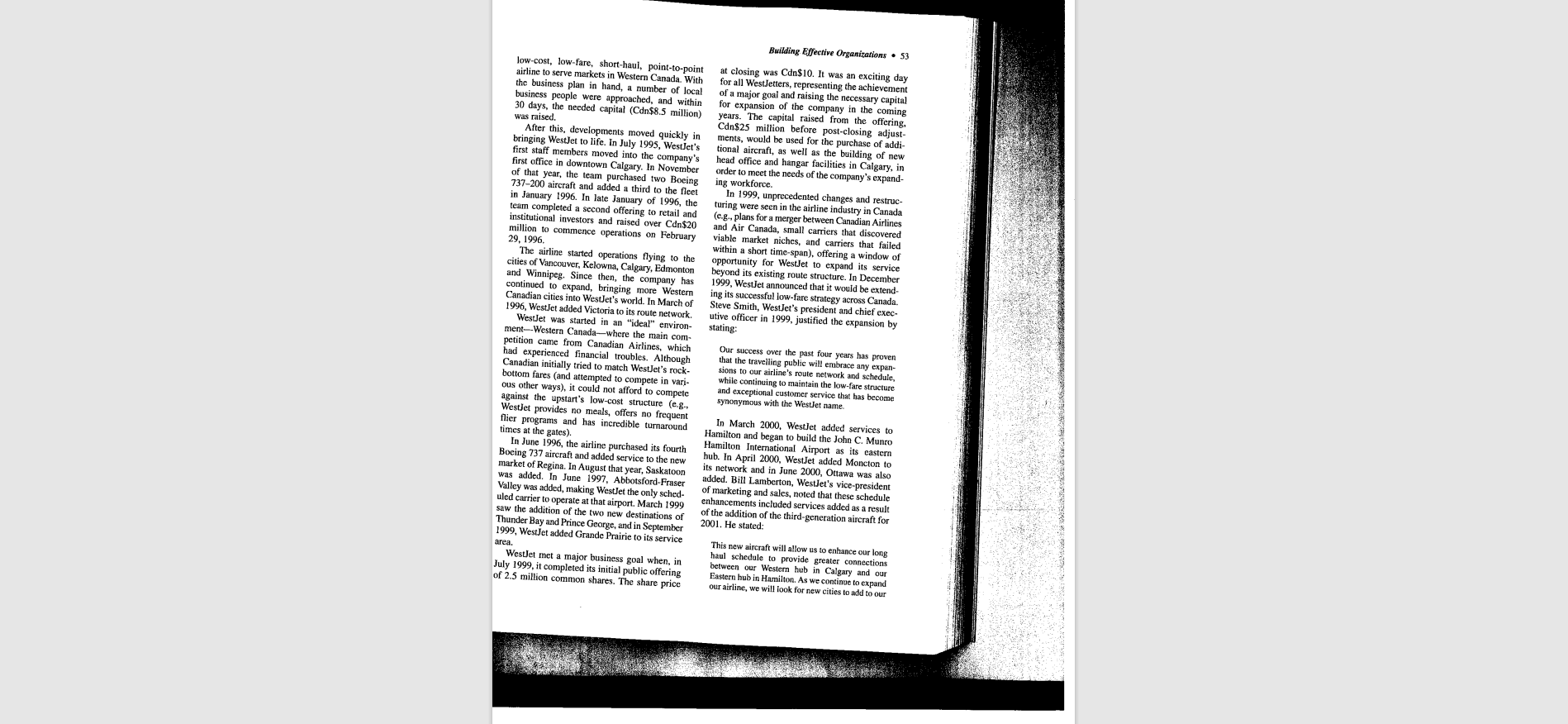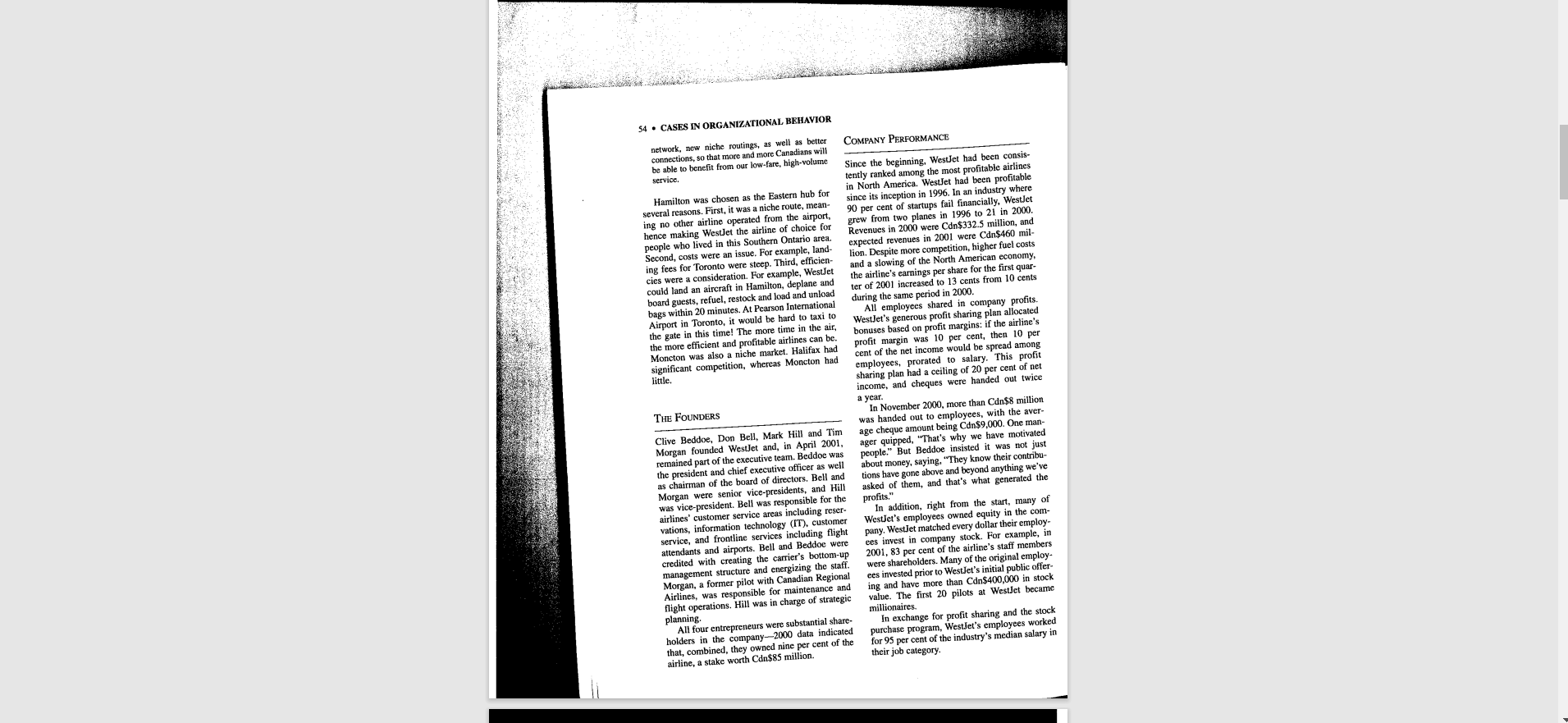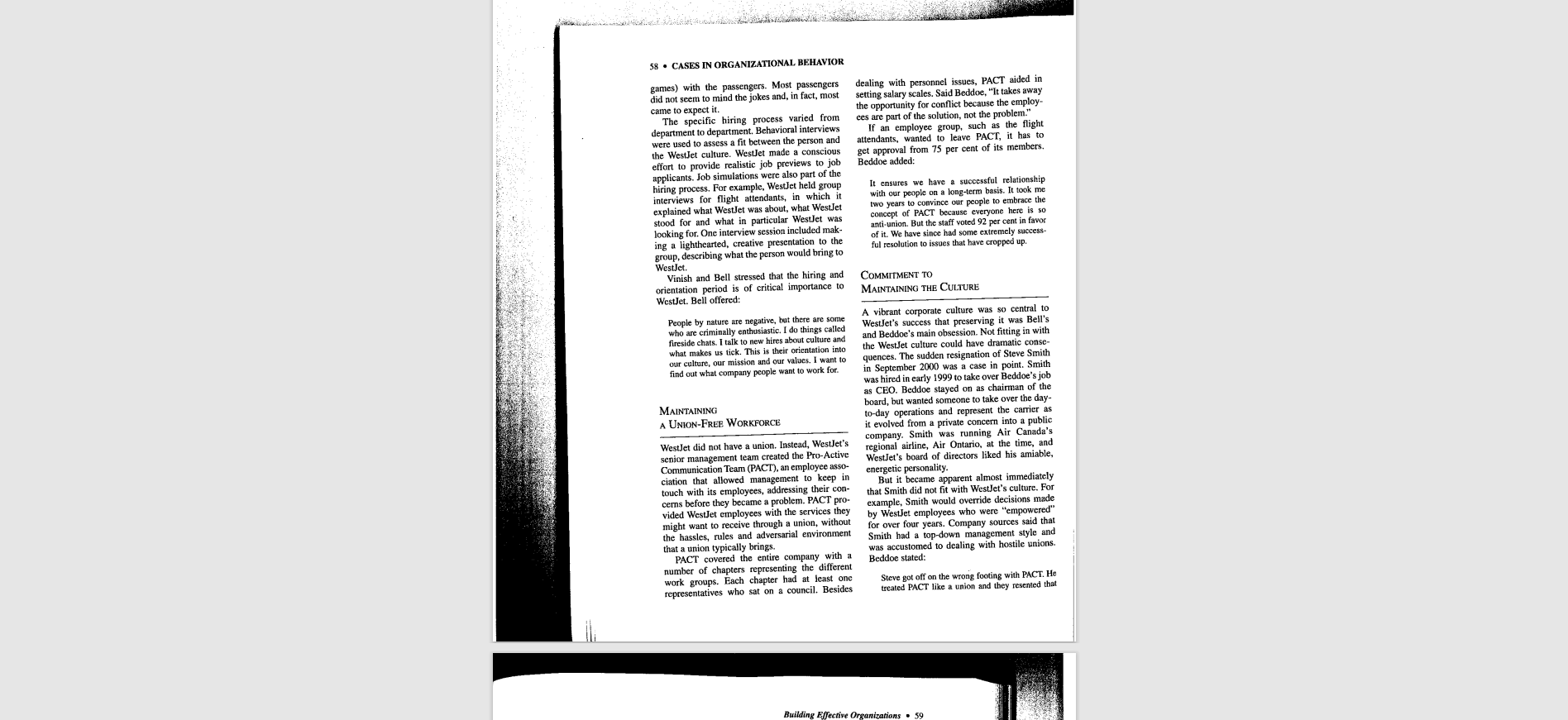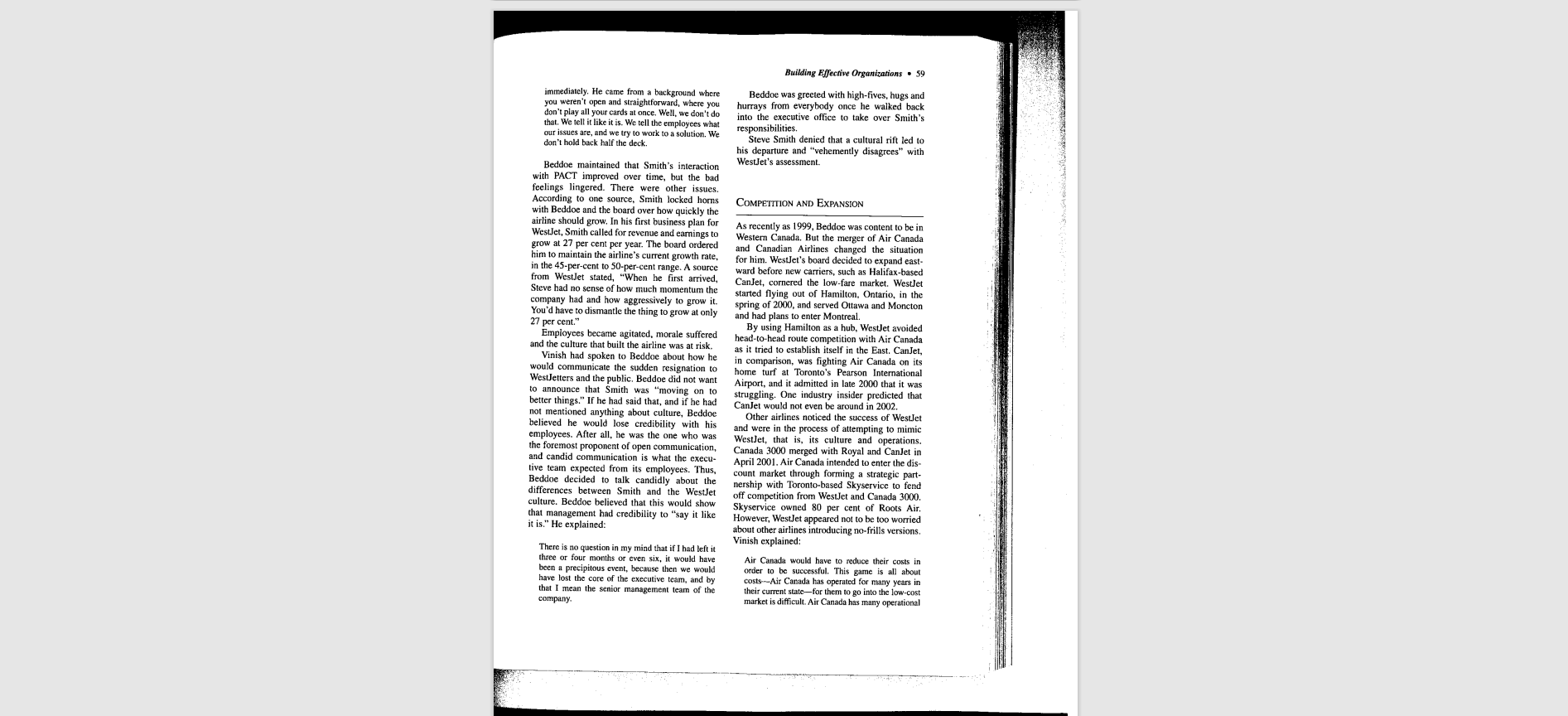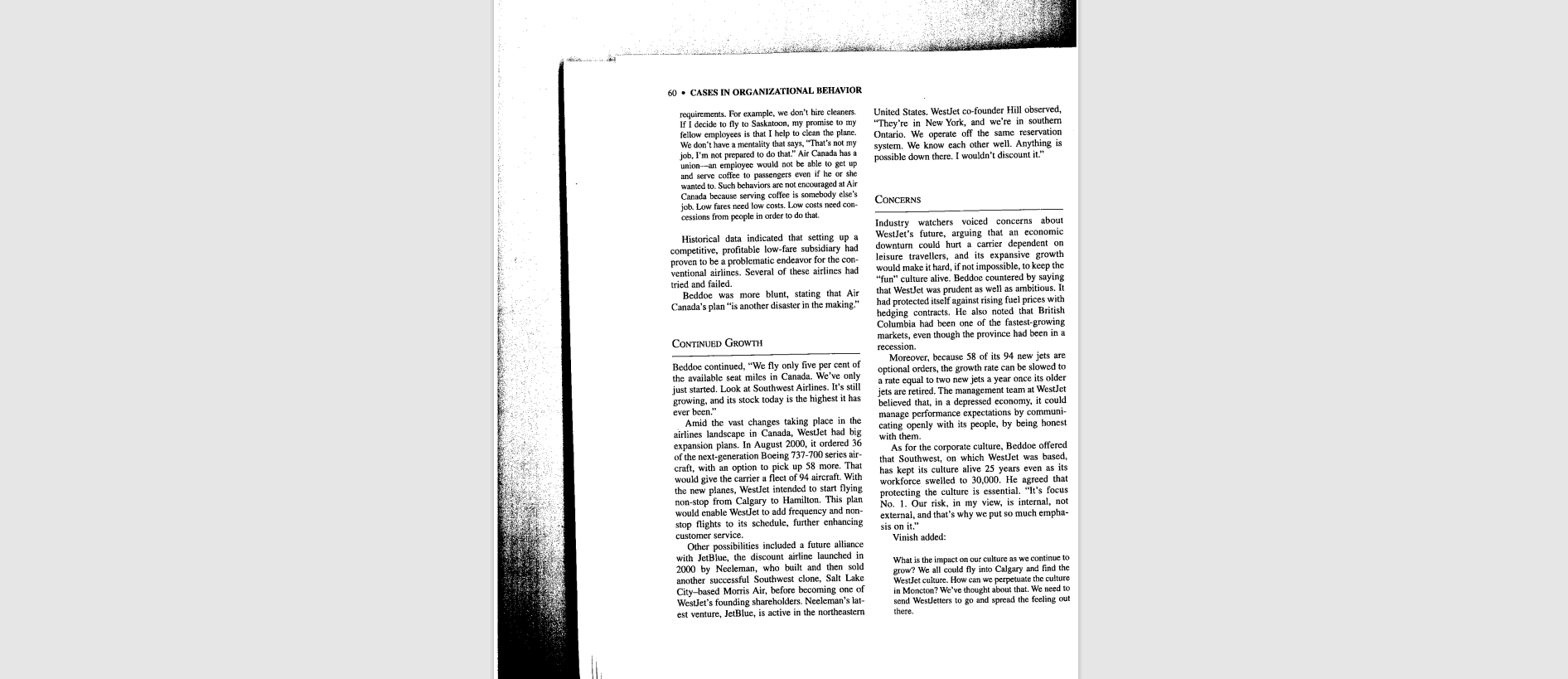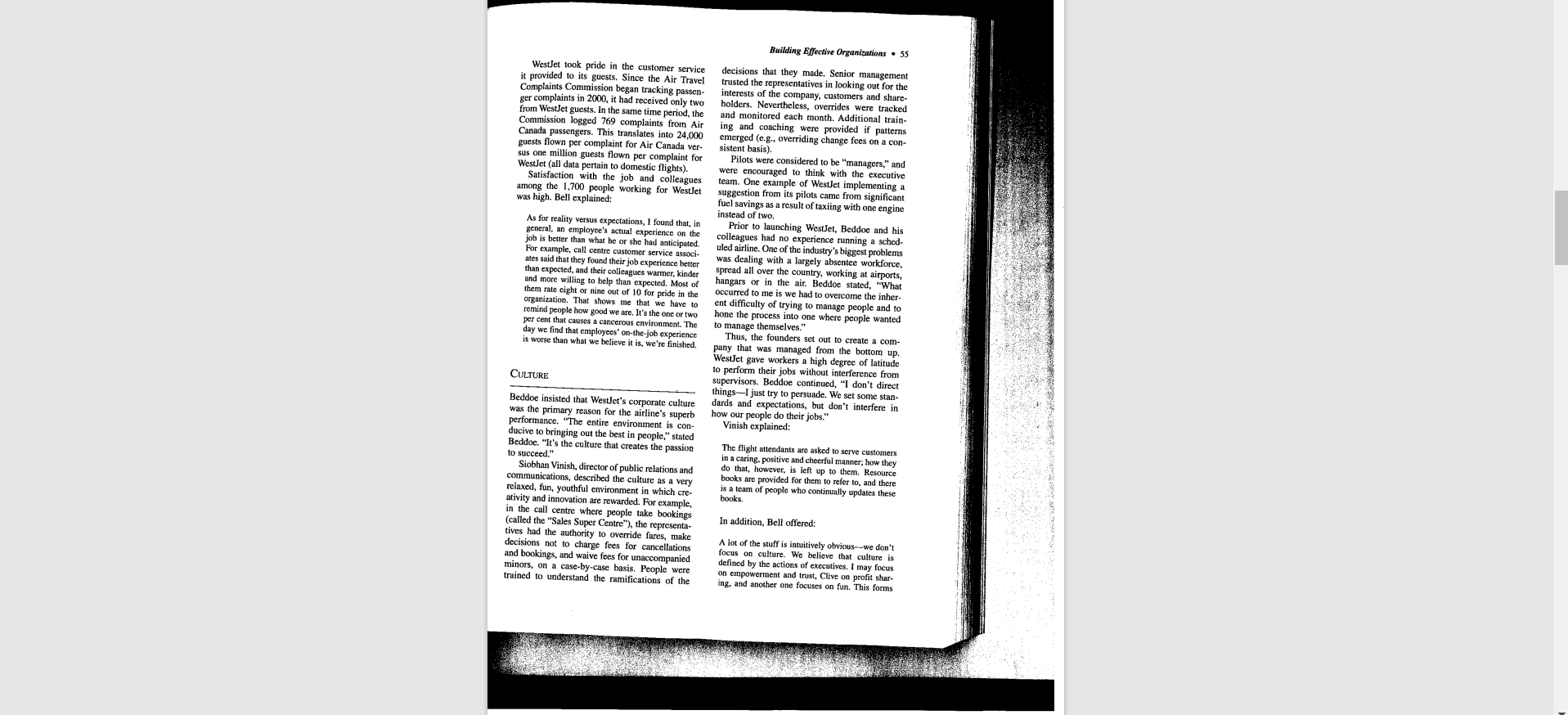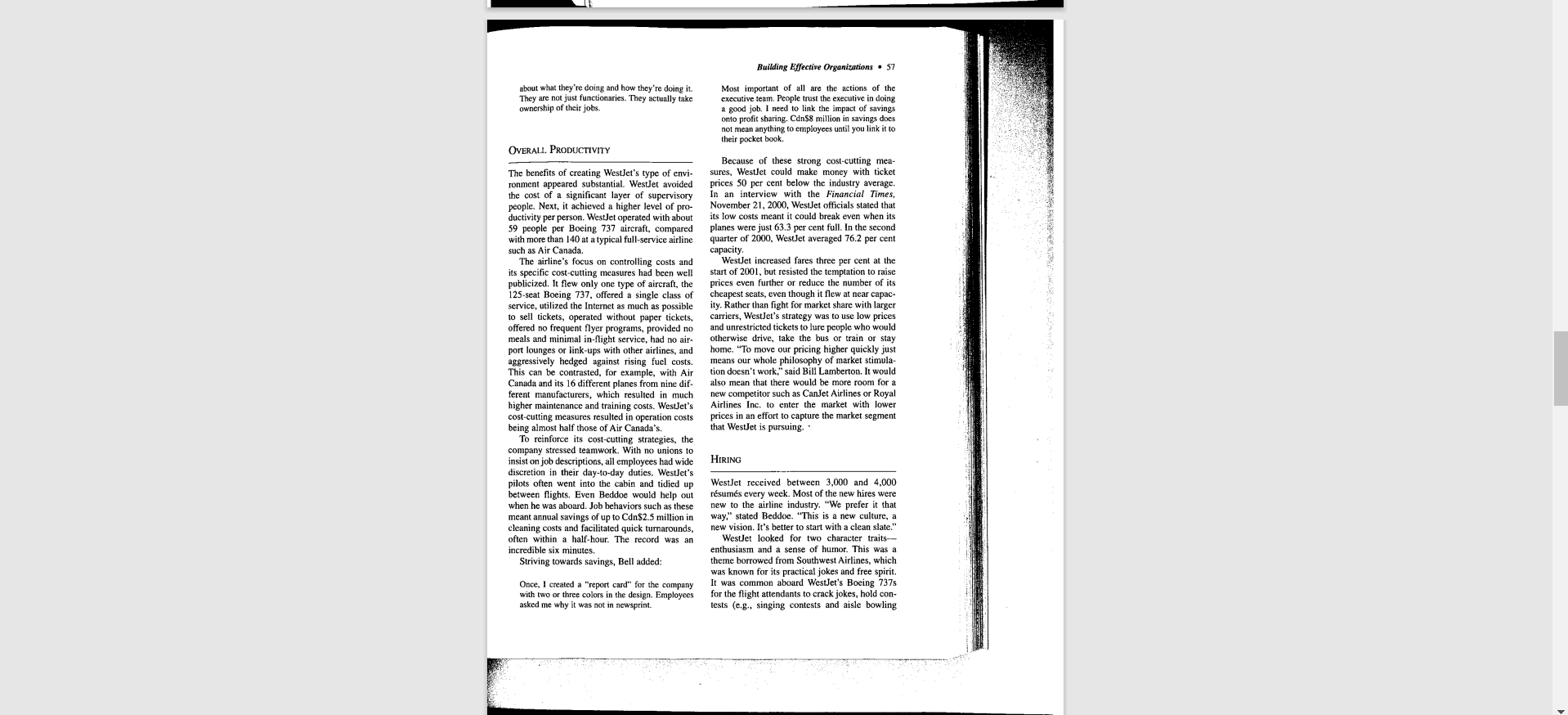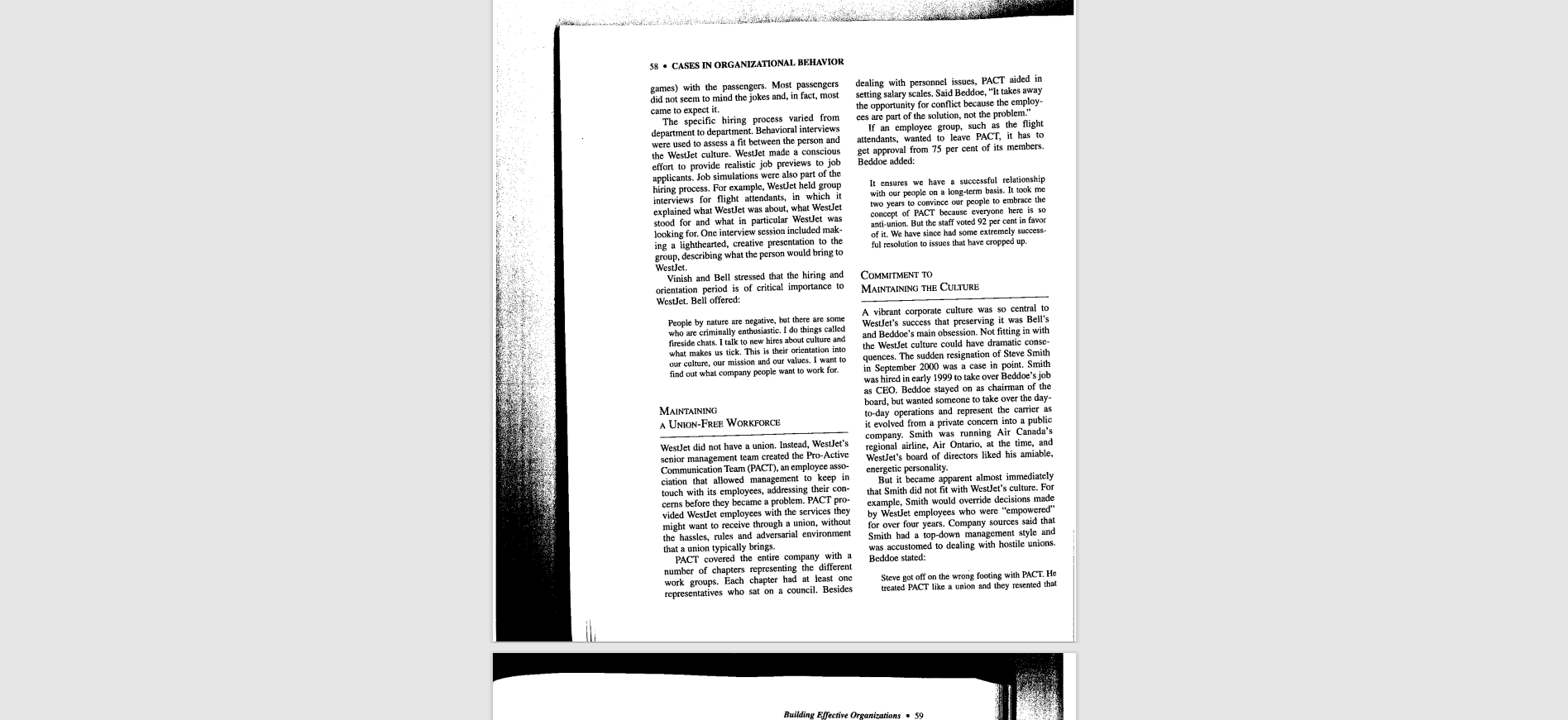
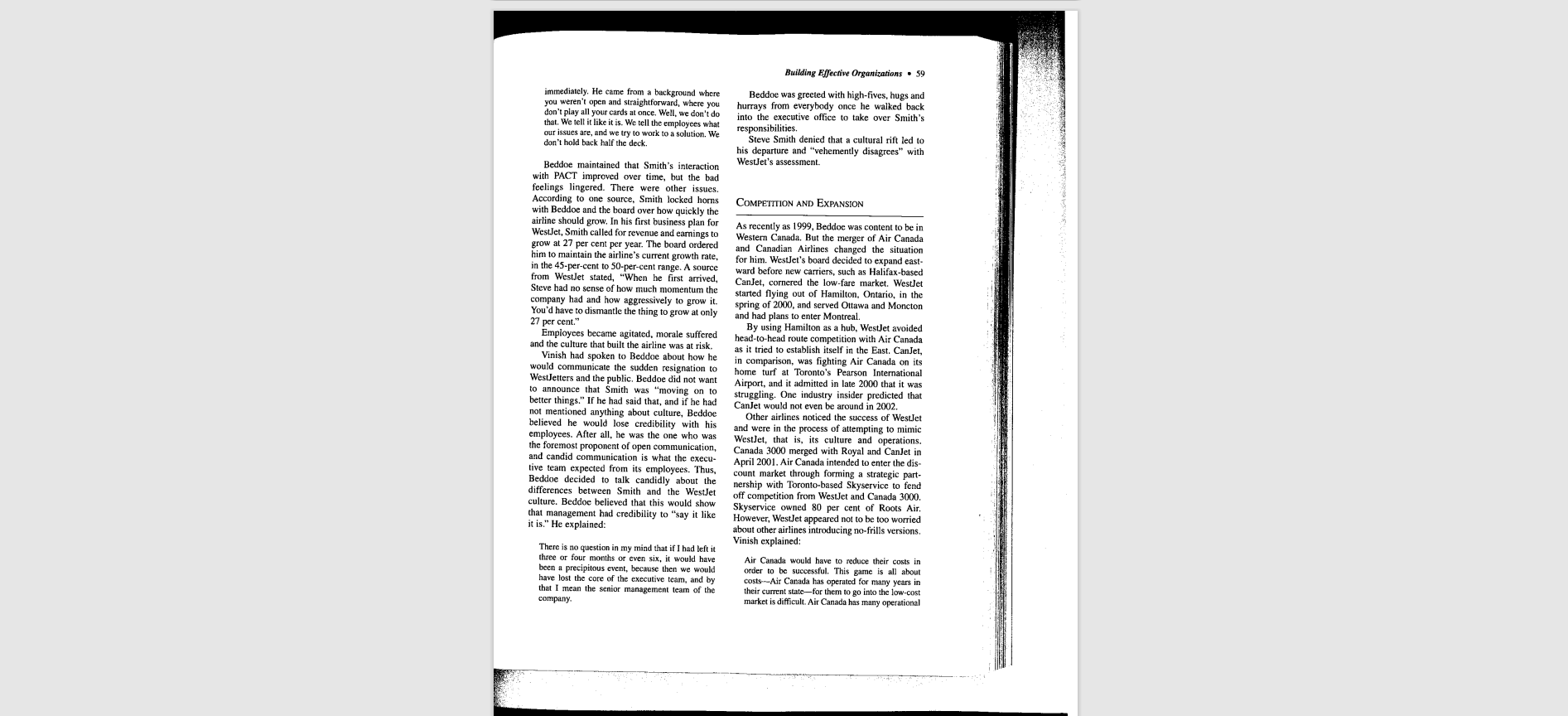


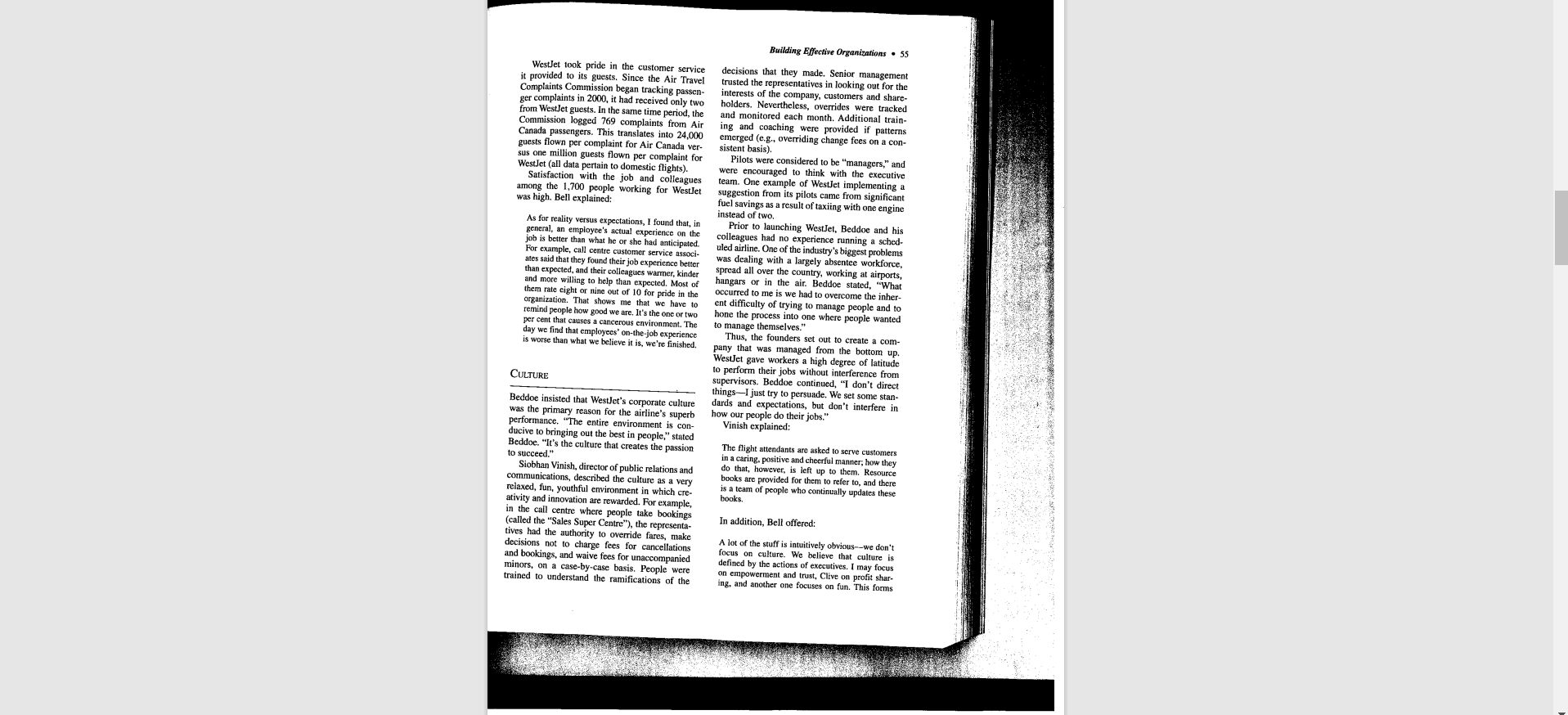
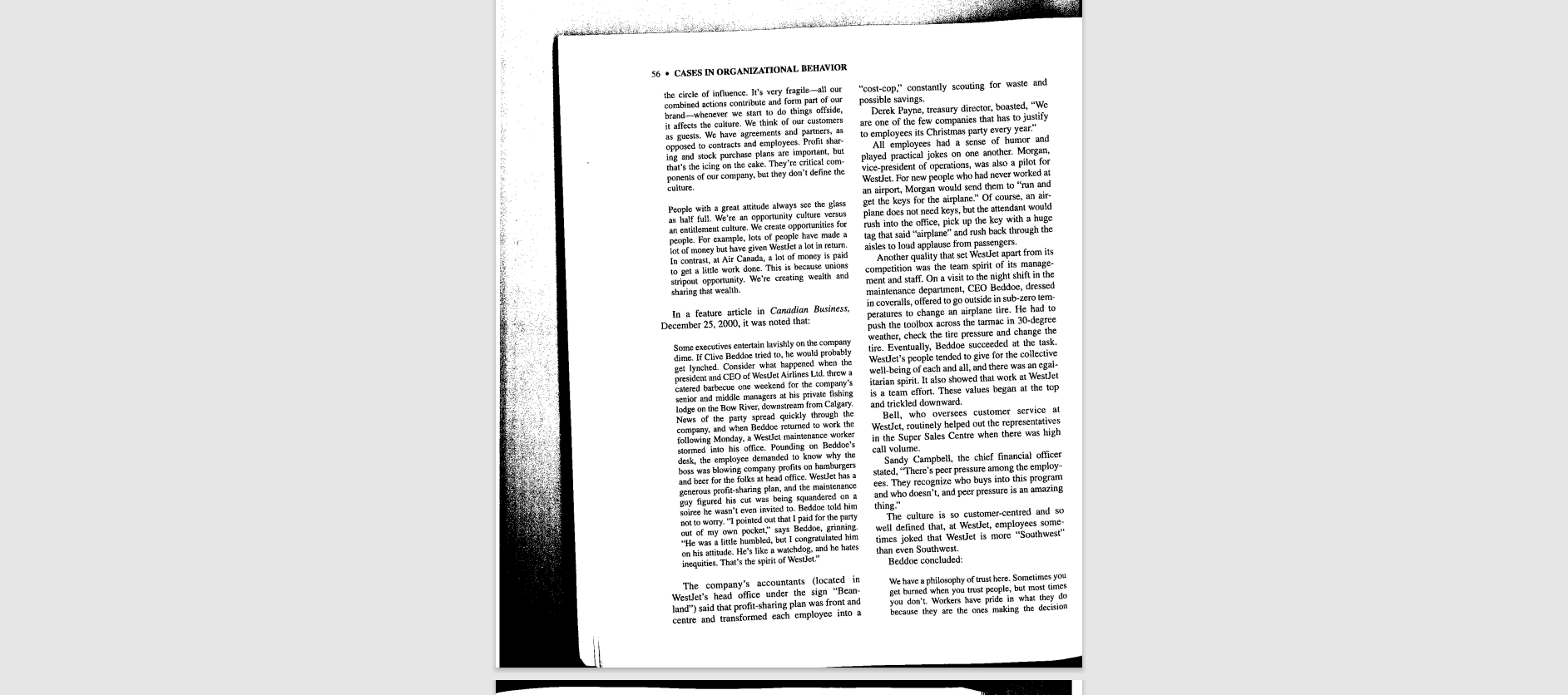
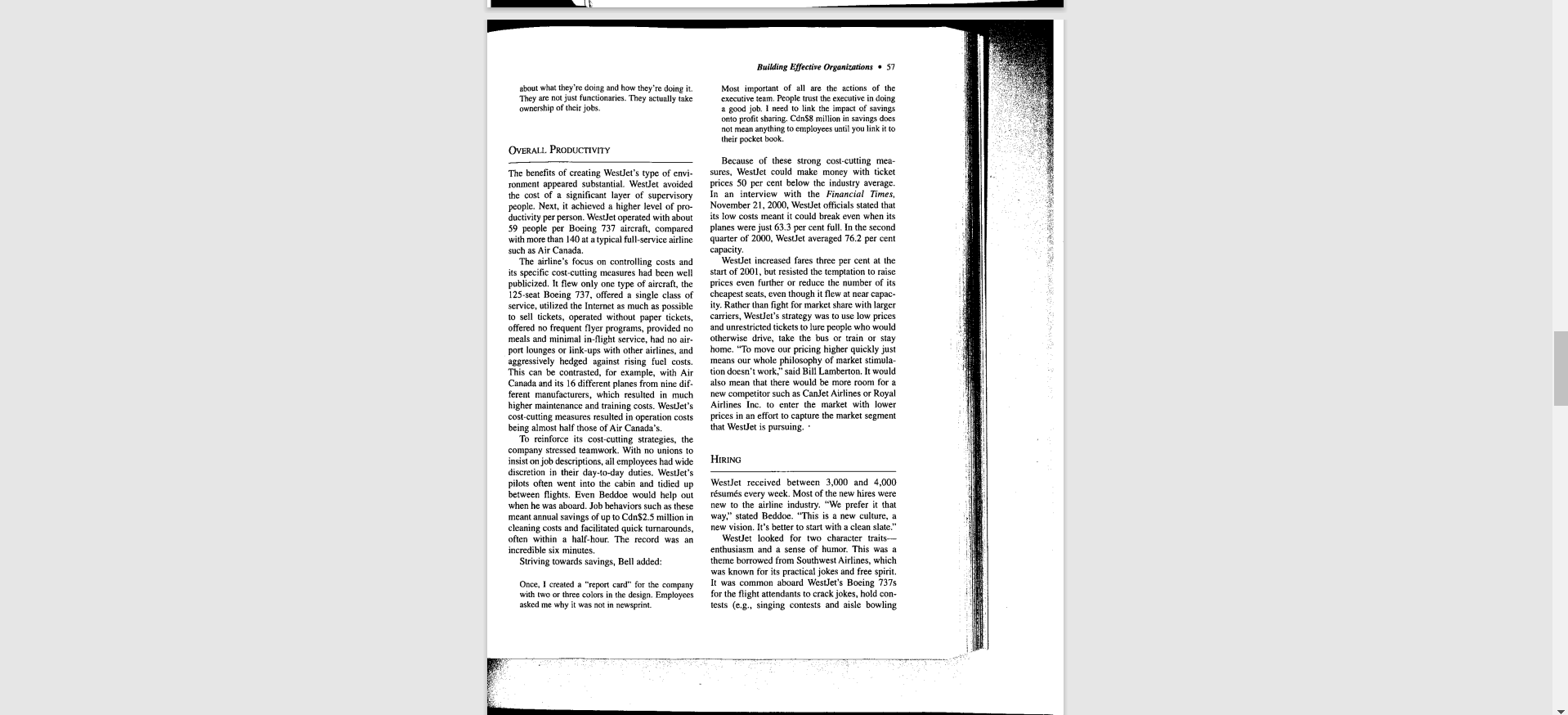
West Jet Case Analysis
Introduction, including relevant facts and background
Problem definition / issues
Critical analysis / conceptualization
Alternatives, which may be "bulletized".
Solution: state the best of the alternatives and the rationale
52 . CASES IN ORGANIZATIONAL BEHAVIOR revisited the vision statement. The upcoming NOTE weeks would be crucial because Matthew won- dered if the still-nascent state of OP4.com's cul- 1. Source: Jupiter Communications, 2000. ture at its Vancouver head office would survive his restructuring. WESTJET AIRLINES (A): THE CULTURE THAT BREEDS A PASSION TO SUCCEED Prepared by Ken Mark under the supervision of Professor Gerard Seijts Copyright 2001, Ivey Management Services Version: (A) 2004-07-09 INTRODUCTION was not using this aircraft, Beddoe made it avail- able for charter to other cost-conscious business It was April 17, 2001, and WestJet's market people through Morgan Air, owned and operated capitalization had just surpassed that of Air by Tim Morgan. The response to this venture Canada's, the country's leading airline. "We're caused Morgan-along with Calgary business- in the hospitality business and our culture is men Don Bell and Mark Hill-to realize that everything to us," stated Don Bell, co-founder there was an opportunity to satisfy the need in and senior vice-president of customer service Western Canada for affordable air travel coupled of Calgary-based WestJet Airlines. Bell was with good service by starting an airline. adamant on maintaining Westlet's culture in Beddoc, Bell, Hill and Morgan believed that the face of increased company growth and com- there was not only a market for a low-fare carrier petition. All of WestJet's founders believed that in Canada, but that they could succeed at bring- culture was the key to their airline's continued ing this service to the country. Through research- success and that they could not afford to mis- ing other successful airlines in North America, manage it. However, Bell knew that the tremen- the team examined low-cost carriers throughout dous growth at WestJet would put pressures the continent, including the primary examples on its unique culture. He wondered how WestJet of Southwest Airlines and Morris Air (which could grow and maintain its vibrant culture. later became part of Southwest Airlines), both operating in the United States. David Necleman, president of Morris Air, was contacted for assis- THE HISTORY OF WESTJET AIRLINES tance on writing a business plan, and along with Morgan, Hill, Bell and Beddoe, became the found The roots of WestJet Airlines go back to 1994, ing team of the concept that became WestJet when entrepreneur Clive Beddoe (president of Airlines. the Hanover Group of Companies) discovered Over the next months, the team worked with that it was cost-effective to purchase an aircraft Necleman to develop a comprehensive business for his weekly business travels between Calgary plan and financial model. This information was and Vancouver. During the time his company the blueprint for the start-up of a three-aircraft,Building Effective Organizations . 53 low-cost, low-fare, short-haul, point-to-point at closing was Cdn$10. It was an exciting day airline to serve markets in Western Canada. With for all WestJetters, representing the achievement the business plan in hand, a number of local of a major goal and raising the necessary capital business people were approached, and within for expansion of the company in the coming 30 days, the needed capital (Cdn$8.5 million) years. The capital raised from the offering, was raised. Can$25 million before post-closing adjust After this, developments moved quickly in ments, would be used for the purchase of addi- bringing WestJet to life. In July 1995, WestJet's tional aircraft, as well as the building of new first staff members moved into the company's head office and hangar facilities in Calgary, in first office in downtown Calgary. In November order to meet the needs of the company's expand- of that year, the team purchased two Boeing ing workforce. 737-200 aircraft and added a third to the fleet In 1999, unprecedented changes and restruc in January 1996. In late January of 1996, the turing were seen in the airline industry in Canada team completed a second offering to retail and (c.g., plans for a merger between Canadian Airlines institutional investors and raised over Cdn$20 and Air Canada, small carriers that discovered million to commence operations on February viable market niches, and carriers that failed 29, 1996. within a short time-span), offering a window of The airline started operations flying to the opportunity for WestJet to expand its service cities of Vancouver, Kelowna, Calgary, Edmonton beyond its existing route structure. In December and Winnipeg. Since then, the company has 1999, WestJet announced that it would be extend- continued to expand, bringing more Western ing its successful low-fare strategy across Canada. Canadian cities into WestJet's world. In March of Steve Smith, WestJet's president and chief exec- 1996, WestJet added Victoria to its route network. utive officer in 1999, justified the expansion by WestJet was started in an "ideal" environ- stating: ment-Western Canada-where the main com- petition came from Canadian Airlines, which Our success over the past four years has proven had experienced financial troubles. Although that the travelling public will embrace any expan- Canadian initially tried to match WestJet's rock- sions to our airline's route network and schedule, bottom fares (and attempted to compete in vari- while continuing to maintain the low-fare structure ous other ways), it could not afford to compete and exceptional customer service that has become against the upstart's low-cost structure (e.g., synonymous with the WestJet name. WestJet provides no meals, offers no frequent flier programs and has incredible turnaround In March 2000, WestJet added services to times at the gates). Hamilton and began to build the John C. Munro In June 1996, the airline purchased its fourth Hamilton International Airport as its eastern Boeing 737 aircraft and added service to the new hub. In April 2000, WestJet added Moncton to market of Regina. In August that year, Saskatoon its network and in June 2000, Ottawa was also was added. In June 1997, Abbotsford-Fraser added. Bill Lamberton, WestJet's vice-president Valley was added, making WestJet the only sched- of marketing and sales, noted that these schedule uled carrier to operate at that airport. March 1999 enhancements included services added as a result saw the addition of the two new destinations of of the addition of the third-generation aircraft for Thunder Bay and Prince George, and in September 2001. He stated: 1999, WestJet added Grande Prairie to its service area. This new aircraft will allow us to enhance our long haul schedule to provide greater connections WestJet met a major business goal when, in between our Western hub in Calgary and our July 1999, it completed its initial public offering Eastern hub in Hamilton. As we continue to expand of 2.5 million common shares. The share price our airline, we will look for new cities to add to our54 . CASES IN ORGANIZATIONAL BEHAVIOR network, new niche routings, as well as better COMPANY PERFORMANCE connections, so that more and more Canadians will be able to benefit from our low-fare, high-volume service. Since the beginning, WestJet had been consis- tently ranked among the most profitable airlines Hamilton was chosen as the Eastern hub for in North America. WestJet had been profitable several reasons. First, it was a niche route, mean- since its inception in 1996. In an industry where ing no other airline operated from the airport, 90 per cent of startups fail financially, WestJet hence making WestJet the airline of choice for grew from two planes in 1996 to 21 in 2000. people who lived in this Southern Ontario area. Revenues in 2000 were Can$332.5 million, and Second, costs were an issue. For example, land- expected revenues in 2001 were Can$460 mil- ing fees for Toronto were steep. Third, efficien- lion. Despite more competition, higher fuel costs cies were a consideration. For example, WestJet and a slowing of the North American economy, could land an aircraft in Hamilton, deplane and the airline's earnings per share for the first quar- board guests, refuel, restock and load and unload ter of 2001 increased to 13 cents from 10 cents bags within 20 minutes. At Pearson International during the same period in 2000. Airport in Toronto, it would be hard to taxi to All employees shared in company profits the gate in this time! The more time in the air, WestJet's generous profit sharing plan allocated the more efficient and profitable airlines can be. bonuses based on profit margins: if the airline's Moncton was also a niche market. Halifax had profit margin was 10 per cent, then 10 per significant competition, whereas Moncton had cent of the net income would be spread among little. employees, prorated to salary. This profit sharing plan had a ceiling of 20 per cent of net income, and cheques were handed out twice a year. THE FOUNDERS In November 2000, more than Can$8 million was handed out to employees, with the aver- Clive Beddoe, Don Bell, Mark Hill and Tim age cheque amount being Can$9,000. One man Morgan founded WestJet and, in April 2001, ager quipped, "That's why we have motivated remained part of the executive team. Beddoe was people." But Beddoe insisted it was not just the president and chief executive officer as well about money, saying, "They know their contribu- as chairman of the board of directors, Bell and tions have gone above and beyond anything we've Morgan were senior vice-presidents, and Hill asked of them, and that's what generated the was vice-president. Bell was responsible for the profits." airlines' customer service areas including reser- In addition, right from the start, many of vations, information technology (IT), customer WestJet's employees owned equity in the com- service, and frontline services including flight pany. WestJet matched every dollar their employ- attendants and airports. Bell and Beddoe were ees invest in company stock. For example, in credited with creating the carrier's bottom-up 2001, 83 per cent of the airline's staff members management structure and energizing the staff. were shareholders. Many of the original employ- Morgan, a former pilot with Canadian Regional ees invested prior to WestJet's initial public offer- Airlines, was responsible for maintenance and ing and have more than Cdn$400,000 in stock flight operations. Hill was in charge of strategic value. The first 20 pilots at WestJet became planning. millionaires. All four entrepreneurs were substantial share- In exchange for profit sharing and the stock holders in the company-2000 data indicated purchase program, WestJet's employees worked that, combined, they owned nine per cent of the for 95 per cent of the industry's median salary in airline, a stake worth Can$85 million. their job category.58 . CASES IN ORGANIZATIONAL BEHAVIOR games) with the passengers. Most passengers dealing with personnel issues, PACT aided in did not seem to mind the jokes and, in fact, most setting salary scales. Said Beddoe, "It takes away came to expect it. the opportunity for conflict because the employ The specific hiring process varied from es are part of the solution, not the problem." department to department. Behavioral interviews If an employee group, such as the flight were used to assess a fit between the person and attendants, wanted to leave PACT, it has to the WestJet culture. WestJet made a conscious get approval from 75 per cent of its members. effort to provide realistic job previews to job Beddoe added: applicants. Job simulations were also part of the hiring process. For example, WestJet held group It ensures we have a successful relationship interviews for flight attendants, in which it with our people on a long-term basis. It took me explained what WestJet was about, what WestJet two years to convince our people to embrace the stood for and what in particular WestJet was concept of PACT because everyone here is so looking for. One interview session included mak- anti-union. But the staff voted 92 per cent in favor ing a lighthearted, creative presentation to the of it. We have since had some extremely success- ful resolution to issues that have cropped up. group, describing what the person would bring to WestJet. Vinish and Bell stressed that the hiring and COMMITMENT TO orientation period is of critical importance to WestJet. Bell offered: MAINTAINING THE CULTURE People by nature are negative, but there are some A vibrant corporate culture was so central to who are criminally enthusiastic. I do things called WestJet's success that preserving it was Bell's fireside chats. I talk to new hires about culture and and Beddoe's main obsession. Not fitting in with what makes us tick. This is their orientation into the WestJet culture could have dramatic conse- our culture, our mission and our values. I want to quences. The sudden resignation of Steve Smith find out what company people want to work for. in September 2000 was a case in point. Smith was hired in early 1999 to take over Beddoe's job as CEO. Beddoe stayed on as chairman of the MAINTAINING board, but wanted someone to take over the day- A UNION-FREE WORKFORCE to-day operations and represent the carrier as it evolved from a private concern into a public WestJet did not have a union. Instead, WestJet's company. Smith was running Air Canada's regional airline, Air Ontario, at the time, and senior management team created the Pro-Active WestJet's board of directors liked his amiable, Communication Team (PACT), an employee asso- ciation that allowed management to keep in energetic personality. But it became apparent almost immediately touch with its employees, addressing their con- that Smith did not fit with Westlet's culture. For cerns before they became a problem. PACT pro- vided WestJet employees with the services they example, Smith would override decisions made might want to receive through a union, without by WestJet employees who were "empowered" for over four years. Company sources said that the hassles, rules and adversarial environment Smith had a top-down management style and that a union typically brings. was accustomed to dealing with hostile unions PACT covered the entire company with a Beddoe stated: number of chapters representing the different work groups. Each chapter had at least one Steve got off on the wrong footing with PACT. He representatives who sat on a council. Besides treated PACT like a union and they resented thatBuilding Effective Organizations . 59 immediately. He came from a background where Beddoe was greeted with high-fives, hugs and you weren't open and straightforward, where you hurrays from everybody once he walked back don't play all your cards at once, Well, we don't do into the executive office to take over Smith's that. We tell it like it is. We tell the employees what our issues are, and we try to work to a solution. We responsibilities. don't hold back half the deck. Steve Smith denied that a cultural rift led to his departure and "vehemently disagrees" with Beddoe maintained that Smith's interaction WestJet's assessment. with PACT improved over time, but the bad feelings lingered. There were other issues. According to one source, Smith locked horns COMPETITION AND EXPANSION with Beddoe and the board over how quickly the airline should grow. In his first business plan for As recently as 1999, Beddoc was content to be in WestJet, Smith called for revenue and earnings to Western Canada. But the merger of Air Canada grow at 27 per cent per year. The board ordered and Canadian Airlines changed the situation him to maintain the airline's current growth rate, for him. WestJet's board decided to expand east in the 45-per-cent to 50-per-cent range. A source ward before new carriers, such as Halifax-based from WestJet stated, "When he first arrived, Steve had no sense of how much momentum the CanJet, cornered the low-fare market. WestJet company had and how aggressively to grow it. started flying out of Hamilton, Ontario, in the spring of 2000, and served Ottawa and Moncton You'd have to dismantle the thing to grow at only 27 per cent." and had plans to enter Montreal. By using Hamilton as a hub, WestJet avoided Employees became agitated, morale suffered head-to-head route competition with Air Canada and the culture that built the airline was at risk. as it tried to establish itself in the East. CanJet, Vinish had spoken to Beddoe about how he in comparison, was fighting Air Canada on its would communicate the sudden resignation to home turf at Toronto's Pearson International WestJetters and the public. Beddoe did not want Airport, and it admitted in late 2000 that it was to announce that Smith was "moving on to struggling. One industry insider predicted that better things." If he had said that, and if he had CanJet would not even be around in 2002, not mentioned anything about culture, Beddoe Other airlines noticed the success of WestJet believed he would lose credibility with his and were in the process of attempting to mimic employees. After all, he was the one who was WestJet, that is, its culture and operations. the foremost proponent of open communication, Canada 3000 merged with Royal and Canlet in and candid communication is what the execu- April 2001. Air Canada intended to enter the dis- tive team expected from its employees. Thus, Beddoe decided to talk candidly about the count market through forming a strategic part- nership with Toronto-based Skyservice to fend differences between Smith and the WestJet off competition from WestJet and Canada 3000. culture. Beddoc believed that this would show Skyservice owned 80 per cent of Roots Air. that management had credibility to "say it like However, WestJet appeared not to be too worried it is." He explained: about other airlines introducing no-frills versions. Vinish explained: There is no question in my mind that if I had left it three or four months or even six, it would have Air Canada would have to reduce their costs in been a precipitous event, because then we would order to be successful. This game is all about have lost the core of the executive team, and by costs-Air Canada has operated for many years in that I mean the senior management team of the their current state-for them to go into the low-cost company. market is difficult. Air Canada has many operational60 . CASES IN ORGANIZATIONAL BEHAVIOR requirements. For example, we don't hire cleaners. United States. WestJet co-founder Hill observed, If I decide to fly to Saskatoon, my promise to my "They're in New York, and we're in southern fellow employees is that I help to clean the plane. We don't have a mentality that says, "That's not my Ontario. We operate off the same reservation job, I'm not prepared to do that." Air Canada has a system. We know each other well. Anything is union-an employee would not be able to get up possible down there. I wouldn't discount it." and serve coffee to passengers even if he or she wanted to. Such behaviors are not encouraged at Air Canada because serving coffee is somebody else's job. Low fares need low costs. Low costs need con- CONCERNS cessions from people in order to do that. Industry watchers voiced concerns about Historical data indicated that setting up a WestJet's future, arguing that an economic competitive, profitable low-fare subsidiary had downturn could hurt a carrier dependent on proven to be a problematic endeavor for the con- leisure travellers, and its expansive growth ventional airlines. Several of these airlines had would make it hard, if not impossible, to keep the tried and failed. "fun" culture alive. Beddoe countered by saying Beddoe was more blunt, stating that Air that WestJet was prudent as well as ambitious. It Canada's plan "is another disaster in the making." had protected itself against rising fuel prices with hedging contracts. He also noted that British Columbia had been one of the fastest-growing CONTINUED GROWTH markets, even though the province had been in a recession. Beddoe continued, "We fly only five per cent of Moreover, because 58 of its 94 new jets are the available seat miles in Canada. We've only optional orders, the growth rate can be slowed to just started. Look at Southwest Airlines. It's still a rate equal to two new jets a year once its older growing, and its stock today is the highest it has jets are retired. The management team at WestJet ever been." believed that, in a depressed economy, it could Amid the vast changes taking place in the manage performance expectations by communi- airlines landscape in Canada, WestJet had big cating openly with its people, by being honest expansion plans. In August 2000, it ordered 36 with them. of the next-generation Boeing 737-700 series air- As for the corporate culture, Beddoe offered craft, with an option to pick up 58 more. That that Southwest, on which WestJet was based, would give the carrier a fleet of 94 aircraft. With has kept its culture alive 25 years even as its the new planes, WestJet intended to start flying workforce swelled to 30,000. He agreed that non-stop from Calgary to Hamilton. This plan protecting the culture is essential. "It's focus would enable WestJet to add frequency and non- No. 1. Our risk, in my view, is internal, not stop flights to its schedule, further enhancing external, and that's why we put so much empha customer service. sis on it." Other possibilities included a future alliance Vinish added: with JetBlue, the discount airline launched in 2000 by Neeleman, who built and then sold What is the impact on our culture as we continue to another successful Southwest clone, Salt Lake grow? We all could fly into Calgary and find the City-based Morris Air, before becoming one of WestJet culture. How can we perpetuate the culture in Moncton? We've thought about that. We need to WestJet's founding shareholders. Neeleman's lat- send Westletters to go and spread the feeling out est venture, JetBlue, is active in the northeastern thereBuilding Effective Organizations . 61 Bell concluded by saying that culture was organization, unable to sustain its culture because paramount at WestJet, that as it grew, it was of its success. essential it kept its unorthodox, irreverent feel He was concerned about not overextending WestJet so that its success would come to a NOTE halt. It would be unfortunate, he thought, if WestJet developed into a big and bureaucratic 1. Taken from www.westjet.com, April 15, 2001.Building Effective Organizations . 55 WestJet took pride in the customer service decisions that they made. Senior management it provided to its guests. Since the Air Travel trusted the representatives in looking out for the Complaints Commission began tracking passen- interests of the company, customers and share- ger complaints in 2000, it had received only two holders. Nevertheless, overrides were tracked from WestJet guests. In the same time period, the and monitored each month. Additional train- Commission logged 769 complaints from Air ing and coaching were provided if patterns Canada passengers. This translates into 24,000 emerged (e.g., overriding change fees on a con- guests flown per complaint for Air Canada ver- sistent basis). sus one million guests flown per complaint for Pilots were considered to be "managers," and WestJet (all data pertain to domestic flights). were encouraged to think with the executive Satisfaction with the job and colleagues team. One example of WestJet implementing a among the 1,700 people working for WestJet suggestion from its pilots came from significant was high. Bell explained: fuel savings as a result of taxiing with one engine instead of two. As for reality versus expectations, I found that, in Prior to launching WestJet, Beddoe and his general, an employee's actual experience on the job is better than what he or she had anticipated. colleagues had no experience running a sched- For example, call centre customer service asso uled airline. One of the industry's biggest problems ates said that they found their job ex was dealing with a largely absentee workforce, than expected, and their colleagues warmer, kinder spread all over the country, working at airports, and more willing to help than expected. Most of hangars or in the air. Beddoe stated, "What them rate eight or nine out of 10 for pride in the occurred to me is we had to overcome the inher- organization. That shows me that we have to ent difficulty of trying to manage people and to remind people how good we are. It's the one or two hone the process into one where people wanted per cent that causes a cancerous environment. The to manage themselves." day we find that employees' on-the-job experience Thus, the founders set out to create a com- is worse than what we believe it is, we're finished. pany that was managed from the bottom up WestJet gave workers a high degree of latitude to perform their jobs without interference from CULTURE supervisors. Beddoe continued, "I don't direct things-I just try to persuade. We set some stan- Beddoe insisted that WestJet's corporate culture dards and expectations, but don't interfere in was the primary reason for the airline's superb how our people do their jobs." performance. "The entire environment is con Vinish explained: ducive to bringing out the best in people," stated Beddoc. "It's the culture that creates the passion The flight attendants are asked to serve customers to succeed." in a caring, positive and cheerful manner; how they Siobhan Vinish, director of public relations and do that, however, is left up to them. Resource communications, described the culture as a very books are provided for them to refer to, and there relaxed, fun, youthful environment in which cre- is a team of people who continually updates these ativity and innovation are rewarded. For example, books. in the call centre where people take bookings (called the "Sales Super Centre"), the representa- In addition, Bell offered: tives had the authority to override fares, make decisions not to charge fees for cancellations A lot of the stuff is intuitively obvious--we don't and bookings, and waive fees for unaccompanied focus on culture. We believe that culture is defined by the actions of executives. I may focus minors, on a case-by-case basis. People were on empowerment and trust, Clive on profit shar- trained to understand the ramifications of the ing, and another one focuses on fun. This forms56 . CASES IN ORGANIZATIONAL BEHAVIOR the circle of influence. It's very fragile-all our "cost-cop," constantly scouting for waste and combined actions contribute and form part of our possible savings. brand-whenever we start to do things offside, Derek Payne, treasury director, boasted, "We it affects the culture. We think of our customers as guests. We have agreements and partners, as are one of the few companies that has to justify opposed to contracts and employees. Profit shar- to employees its Christmas party every year." ing and stock purchase plans are important, but All employees had a sense of humor and that's the icing on the cake. They're critical com- played practical jokes on one another. Morgan, ponents of our company, but they don't define the vice-president of operations, was also a pilot for culture. WestJet. For new people who had never worked at an airport, Morgan would send them to "run and People with a great attitude always see the glass get the keys for the airplane." Of course, an air- as half full. We're an opportunity culture versus plane does not need keys, but the attendant would an entitlement culture. We create opportunities for rush into the office, pick up the key with a huge people. For example, lots of people have made a tag that said "airplane" and rush back through the lot of money but have given WestJet a lot in return. aisles to loud applause from passengers. In contrast, at Air Canada, a lot of money is paid to get a little work done. This is because unions Another quality that set WestJet apart from its stripout opportunity. We're creating wealth and competition was the team spirit of its manage- sharing that wealth. ment and staff. On a visit to the night shift in the maintenance department, CEO Beddoc, dressed In a feature article in Canadian Business, in coveralls, offered to go outside in sub-zero tem- December 25, 2000, it was noted that: peratures to change an airplane tire. He had to push the toolbox across the tarmac in 30-degree Some executives entertain lavishly on the company weather, check the tire pressure and change the dime. If Clive Beddoe tried to, he would probably tire. Eventually, Beddoe succeeded at the task. get lynched. Consider what happened wi WestJet's people tended to give for the collective president and CEO of WestJet Airlines Lid, threw a well-being of each and all, and there was an egal- catered barbecue one weekend for the company's itarian spirit. It also showed that work at WestJet senior and middle manage s at his private fishing is a team effort. These values began at the top lodge on the Bow River, downstream from Calgary. and trickled downward. News of the party spread quickly through the Bell, who oversees customer service at company, and when Beddoe returned to work the following Monday, a WestJet maintenance worker WestJet, routinely helped out the representatives stormed into his office. Pounding o n Beddoe's in the Super Sales Centre when there was high desk, the employee demanded to know why the call volume. boss was blowing company profits on hamburgers Sandy Campbell, the chief financial officer and beer for the folks at head office. WestJet has a stated, "There's peer pressure among the employ- generous profit-sharing plan, and the aintenance ees. They recognize who buys into this program guy figured his cut was being squandered on a and who doesn't, and peer pressure is an amazing soiree he wasn't even invited to. Beddoe told him thing." not to worry. "I pointed out that I paid for the party The culture is so customer-centred and so out of my own pocket," says Beddoe, g well defined that, at WestJet, employees some- "He was a little humbled, but I congratulated him times joked that WestJet is more "Southwest" on his attitude. He's like a watchdog, and he hates inequities. That's the spirit of WestJet." than even Southwest. Beddoe concluded: The company's accountants (located in WestJet's head office under the sign "Bean We have a philosophy of trust here. Sometimes you get burned when you trust people, but most times land") said that profit-sharing plan was front and you don't. Workers have pride in what they do centre and transformed each employee into a because they are the ones making the decisionBuilding Effective Organizations . 57 about what they're doing and how they're doing it. Most important of all are the actions of the They are not just functionaries. They actually take executive team. People trust the executive in doing ownership of their jobs. a good job. I need to link the impact of savings onto profit sharing. Can$8 million in savings does not mean anything to employees until you link it to their pocket book. OVERALL PRODUCTIVITY Because of these strong cost-cuttin The benefits of creating WestJet's type of envi- sures, Westlet could make money with ticket ronment appeared substantial. WestJet avoided prices 50 per cent below the industry average. the cost of a significant layer of supervisory In an interview with the Financial Times, people. Next, it achieved a higher level of pro- November 21, 2000, WestJet officials stated that ductivity per person. WestJet operated with about its low costs meant it could break even when its 59 people per Boeing 737 aircraft, compared planes were just 63.3 per cent full. In the second with more than 140 at a typical full-service airline quarter of 2000, WestJet averaged 76.2 per cent such as Air Canada. capacity. The airline's focus on controlling costs and WestJet increased fares three per cent at the its specific cost-cutting measures had been well start of 2001, but resisted the temptation to raise publicized. It flew only one type of aircraft, the prices even further or reduce the number of its 125-seat Boeing 737, offered a single class of cheapest seats, even though it flew at near capac- service, utilized the Internet as much as possible ity. Rather than fight for market share with larger to sell tickets, operated without paper tickets, carriers, WestJet's strategy was to use low prices offered no frequent flyer programs, provided no and unrestricted tickets to lure people who would meals and minimal in-flight serv had no air- otherwise drive, take the bus or train or stay port lounges or link-ups with other airlines, and home. "To move our pricing higher quickly just aggressively hedged against rising fuel costs. means our whole philosophy of market stimula- This can be contrasted, for example, with Air tion doesn't work," said Bill Lamberton. It would Canada and its 16 different planes from nine dif- also mean that there would be more room for a ferent manufacturers, which resulted in much new competitor such as CanJet Airlines or Royal higher maintenance and training costs. WestJet's Airlines Inc. to enter the market with lower cost-cutting measures resulted in operation costs prices in an effort to capture the market segment being almost half those of Air Canada's that WestJet is pursuing. . To reinforce its cost-cutting strategies, the company stressed teamwork. With no unions to insist on job descriptions, all employees had wide HIRING discretion in their day-to-day duties. Westlet's pilots often went into the cabin and tidied up WestJet received between 3,000 and 4,000 between flights. Even Beddoe would help out resumes every week. Most of the new hires were when he was aboard. Job behaviors such as these new to the airline industry. "We prefer it that meant annual savings of up to Cdn$2.5 million in way," stated Beddoe. "This is a new culture, a cleaning costs and facilitated quick turnarounds, new vision. It's better to start with a clean slate." often within a half-hour. The record was an WestJet looked for two character traits- incredible six minutes. enthusiasm and a sense of humor. This was a Striving towards savings, Bell added theme borrowed from Southwest Airlines, which was known for its practical jokes and free spirit. Once, I created a "report card" for the company It was common aboard WestJet's Boeing 737s with two or three colors in the design. Employees for the flight attendants to crack jokes, hold con- asked me why it was not in newsprint. tests (e.g., singing contests and aisle bowling







